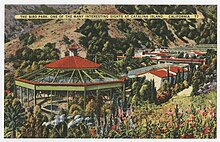Catalina Bird Park
 From Wikipedia the free encyclopedia
From Wikipedia the free encyclopedia
| Catalina Bird Park | |
|---|---|
 Tichnor Brothers postcard, UCSD Library | |
 | |
| 33°20′07″N 118°19′58″W / 33.3353°N 118.3327°W | |
| Date opened | 1926 |
| Date closed | 1966 |
| Location | Santa Catalina Island, California |
 | |
Catalina Bird Park, or Wrigley Bird Park, was a 20th-century collection of exotic birds and game fowl kept on Santa Catalina Island, California, United States, under the sponsorship of the island's owner William Wrigley Jr.[1] The Bird Park was located in Avalon Canyon along the Avalon municipal boundary.[2]
History[edit]
The Bird Park opened in approximately 1926.[3] The Bird Park was meant to be an enticement to visit the island generally and did not produce any revenue.[4] The steel girders from the original dance hall—the one that was replaced by the Catalina Casino—were reused in the construction of the Bird Park aviary in 1928.[4] The resulting cage was 90 ft (27 m) in diameter and 115 ft (35 m) high.[2] Former President and Mrs. Calvin Coolidge paid a visit in 1930.[5] Circa 1931, the aviary was open to tourists, admission was free, and there were more than 5,000 individual birds in the collection.[6] Circa 1934, Out West magazine reported that golden and ring-neck pheasants that had "been liberated" from the Bird Park were adapting well to canyons of the island.[7]
The first supervisor of the aviary, which had a breeding program, was Edward Herbert Lewis.[8] Lewis also designed the park, supervised construction, selected the exhibits,[9] and trained the talking mynahs.[10] Les Mobley was superintendent in 1951 when the bird park successfully hatched and displayed three baby emus.[11] The Catalina macaw, a hybrid macaw which takes its name from the park and is now popular as a pet was first bred in captivity at Catalina Bird Park in 1940.[12] When the Catalina Bird Park aviary closed in 1966, the newly established Los Angeles Zoo purchased the remaining 650 birds for US$14,000 (equivalent to about $131,470 in 2023).[3]
The physical plant was described as being Moorish styled in design and spread over 7.5 acres (3.0 ha).[8] The Bird Park was decorated with Catalina art tiles including several "bird murals" of toucans, macaws, crested cranes, etc.[4] The tiled fountain from the Bird Park was moved to Avalon Plaza after the aviary was shut down.[4] The Bird Park was adjacent to the Catalina Island Golf Course.[13] Some of the bird park structures have been converted into subsidized housing.[14]
Additional images[edit]
- Catalina Bird Park, an attraction of the Southland that could reached via the San Pedro via Dominguez Line (Pacific Electric magazine July–August 1932)
- "Bird Park Apartments on Santa Catalina Island, a rocky island off the coast of California" (Carol Highsmith, 2013)
See also[edit]
- Catalina macaw
- Catalina Island bison herd
- History of Santa Catalina Island § Wrigley ownership (1919–1975)
- Feather Hill Zoo – Animal collection, Santa Barbara, California (1924–1930)
- Universal City Zoo – Animal collection in California (1913–1930)
- Selig Zoo – Animal collection in Los Angeles (~1911–~1940)
References[edit]
- ^ "The Los Angeles Times 21 Jul 1929, page 131". Newspapers.com. Retrieved 2023-04-09.
- ^ a b Overholt, Alma Staheli; Sargent, Jack (1978). The Catalina story. Catalina Island Museum Society, Inc. (3rd ed.). Avalon, California: Island Press. pp. 31 (girders), 33 & 73 (geography) – via Internet Archive.
- ^ a b "The Los Angeles Times 18 Feb 1966, page 3". Newspapers.com. Retrieved 2023-04-09.
- ^ a b c d Rosenthal, Lee (1992). Catalina tile of the magic isle. Internet Archive. Sausalito, Calif. : Windgate Press. pp. 21 (revenue), 31 (frame), 41 (fountain). ISBN 978-0-915269-10-5.
- ^ "The Los Angeles Times 21 Jul 1929, page 131". Newspapers.com. Retrieved 2023-04-09.
- ^ "Los Angeles Evening Express 17 Jan 1931, page 13". Newspapers.com. Retrieved 2023-04-09.
- ^ Overholt, Alma (August 1934). "Wild Life at Catalina". Out West Magazine. Vol. 92, no. 7. Open Court Publishing Co. p. 137 – via Internet Archive.
- ^ a b "Honolulu Star-Bulletin 10 Nov 1934, page 4". Newspapers.com. Retrieved 2023-04-09.
- ^ Nellist, George Ferguson Mitchell (1941). Pan-Pacific who's who, 1940-1941: an international reference work a biographical encyclopedia of men and women of substantial achievement in the Pan-Pacific area: Alaska, Australia, British Columbia, California, Canal Zone, China, Hawaii, Japan, New Zealand, Oregon, Philippines, Washington. Honolulu: Honolulu Star-Bulletin, Ltd.
- ^ "The Los Angeles Times 03 Sep 1933, page 81". Newspapers.com. Retrieved 2023-04-10.
- ^ "Long Beach Press-Telegram 01 Apr 1951, page 50". Newspapers.com. Retrieved 2023-04-09.
- ^ Lindholm III, Joseph H. (1999). "AN HISTORICAL REVIEW OF PARROTS BRED IN ZOOS IN THE USA". The Avicultural Magazine. 105 (4). Retrieved 12 November 2021.
- ^ "A Step Back in Time: Bird Park". www.visitcatalinaisland.com. 2018-01-09. Retrieved 2023-04-10.
- ^ "Bird Park - Thomas Safran & Associates - Affordable Housing Los Angeles". www.tsahousing.com. Retrieved 2023-04-10.

